by Erika Gaffney, Art Herstory Founder
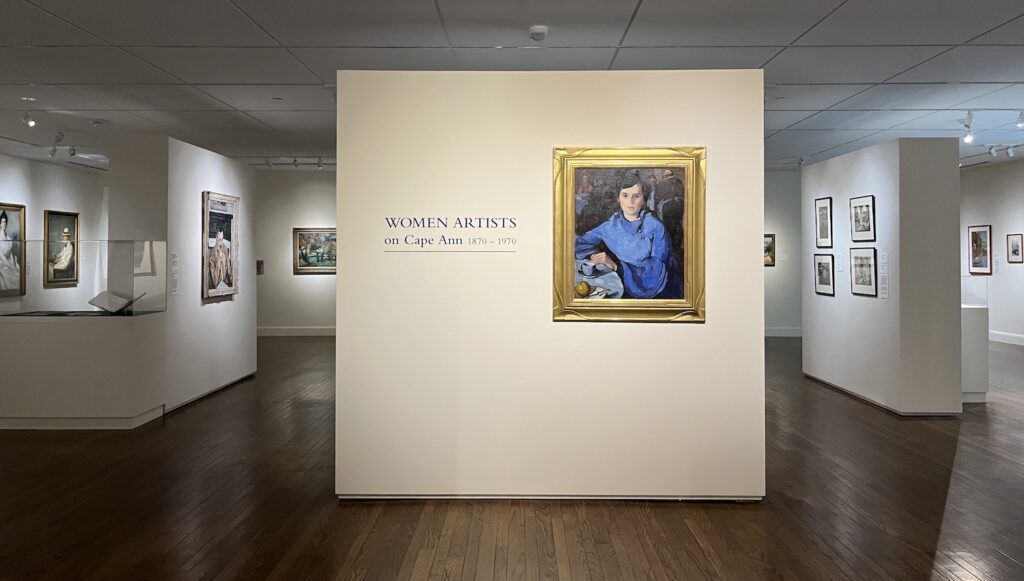
Since the inception of Art Herstory, Gloucester’s Cape Ann Museum (CAM) has been on your correspondent’s radar. The institution contributes meaningfully to the movement to recover historic women artists. It also highlights the creative output of contemporary women. The theme of women and/in art recurs regularly in CAM’s exhibitions, events, acquisitions, and social media posts.
So it was with excitement and real pleasure that this reviewer visited CAM to see Women Artists on Cape Ann 1870–1970. The show did not disappoint; it was rewarding on many levels. And talk about bang for the buck! Works by historic women artists appear in galleries throughout the museum. Also, a display of art by contemporary female artists from CAM’s holdings complements the exhibition.

Eclectic harmony
A notable achievement of this exhibit is that it successfully integrates artworks from across mediums. Though in some ways quite disparate, the objects nevertheless share the space harmoniously.
Wall art
On the walls of the main exhibit room are paintings in oil or watercolor or gouache, etchings, and lithograph prints. Subject matter includes city-, land- or waterscapes; portraits (of self or others); still lifes; summer scenes; and more. Slightly more 3-dimensional wall presentations include linoleum blocks and a ceramic sculpture.
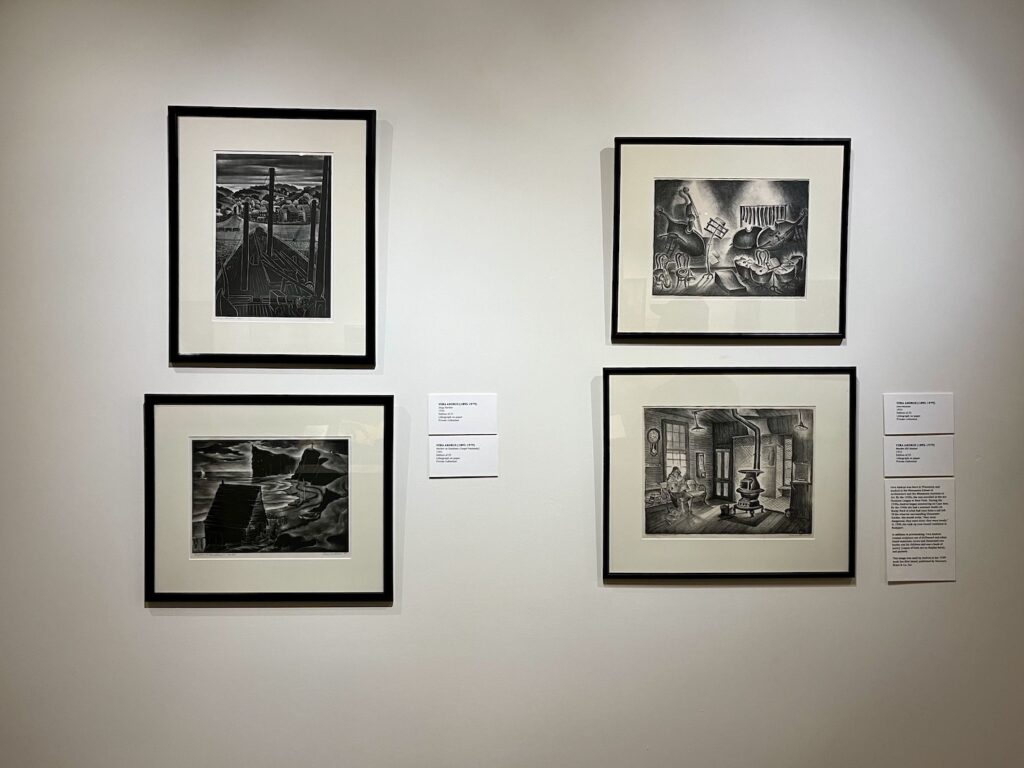
Floor displays
Cases around the room present other kinds of objects, including books that feature illustrations by women. One of these floor displays features ceramic dishes that members of the Saturday Evening Girls (SEG) made for the Paul Revere Pottery. (As the CAM website explains, the SEG was a social club organized in Boston in 1899. Its purpose was to educate young immigrant women and help assimilate them into American culture.)

The three-dimensional artworks on display include metal sculptures—such as Bonaparte’s Gulls, by Marblehead sculptor Beverly Benson Seamans.

Hand-made rugs
A small room off to the side celebrates the artistic collaboration of painter and assemblage artist Mary Shore and weaver Eva Matz. From the walls in this room hang the spectacular hooked rugs that Matz wove according to Shore’s designs, as well as paintings by Shore. The museum’s press release quotes this observation by CAM Chief Curator Martha Oaks: “Matz’s skill at selecting and preparing wool as well as her attention to detail when it came to color and patterning, make the rugs true works of art.” Amen to that.
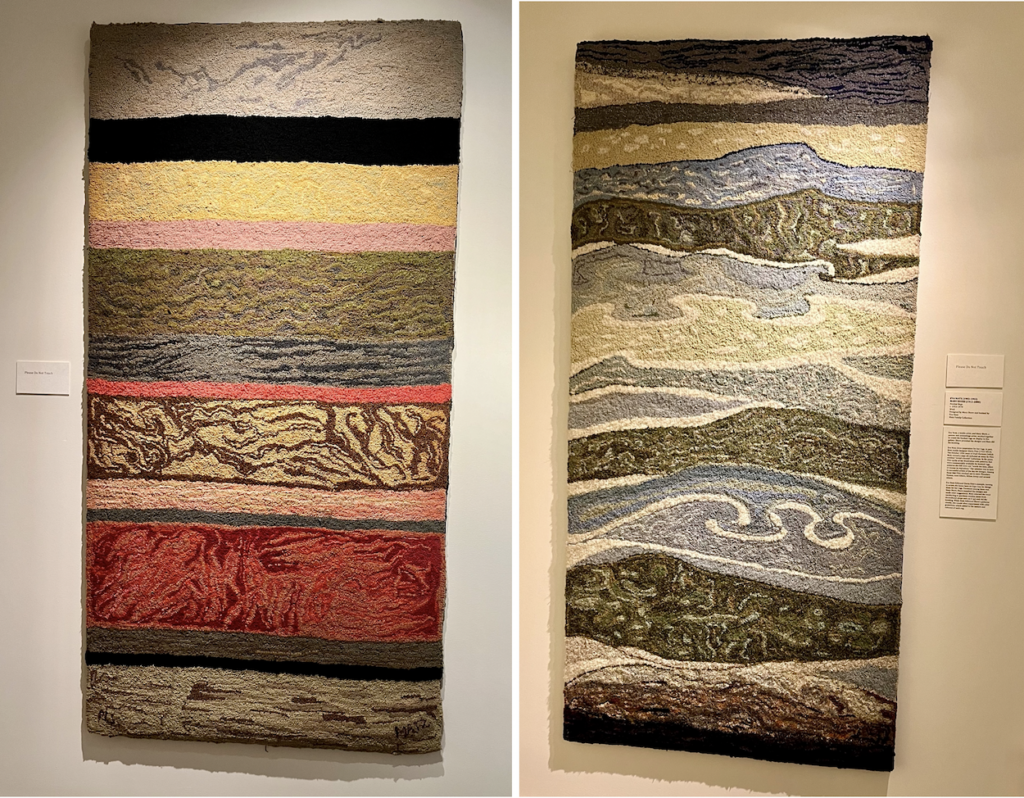
Familiar and less familiar names
Women Artists on Cape Ann 1870–1970 features some prolific artists whose names visitors will immediately recognize. Among these are Jane Peterson, Martha Walter, Alice Beach Winter, and perhaps especially Cecilia Beaux. According to the wall text, Beaux was “one of the most well-known and celebrated female artists to work on Cape Ann.” Her monumental—and newly conserved—painting Victory Bearing Away the Infant Future dominates the main room. Its dimensions may even be larger than those of the rugs next door!
But these better known artists share space with less well known makers. One of the paintings this viewer found most compelling is Garden View, by Mary L. Weiss. The wall text offers very little information about Weiss. An internet search doesn’t yield up much more, other than a reference to a Weiss work sold at auction in 2007.
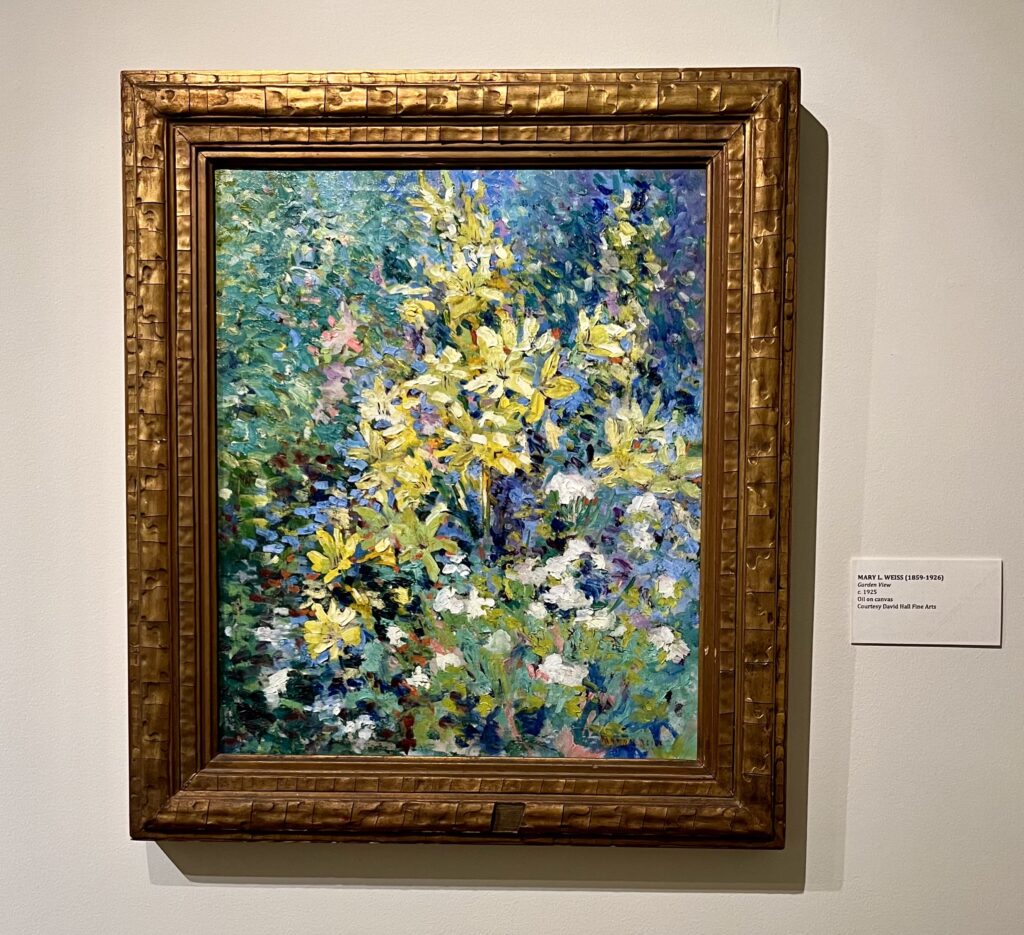
Whence these artworks?
The Cape Ann Museum owns many of the works in Women Artists on Cape Ann 1870–1970, but not all of them. Loaning museums include Rockport Art Association and Museum and Wellesley College’s Davis Museum. Numerous private collectors contribute to the exhibition; at least half a dozen have their names included in the label, though some remain anonymous. Thus the exhibition offers the viewing public rare access to some of these artworks.
Women artists museum-wide
Currently CAM dedicates the remainder of the third floor to art by contemporary women, sourced from its permanent collection. To single out just a few eye-catching works in this section of the building:
- Winter, by Susan Erony, wrought of burnt paper and acrylic paint, is new to the collection as of this year.
- Surrounded by Water, a quilt by Clara Wainwright, supplied the title of a 2010 solo exhibition at CAM of work by the artist, who gifted the textile to the museum in 2019.
- A couple of years ago CAM presented an exhibition of work by Judi Rotenberg. Visitors now have an opportunity to see the painter’s powerful Still Life and Motif in Cad Red Light.
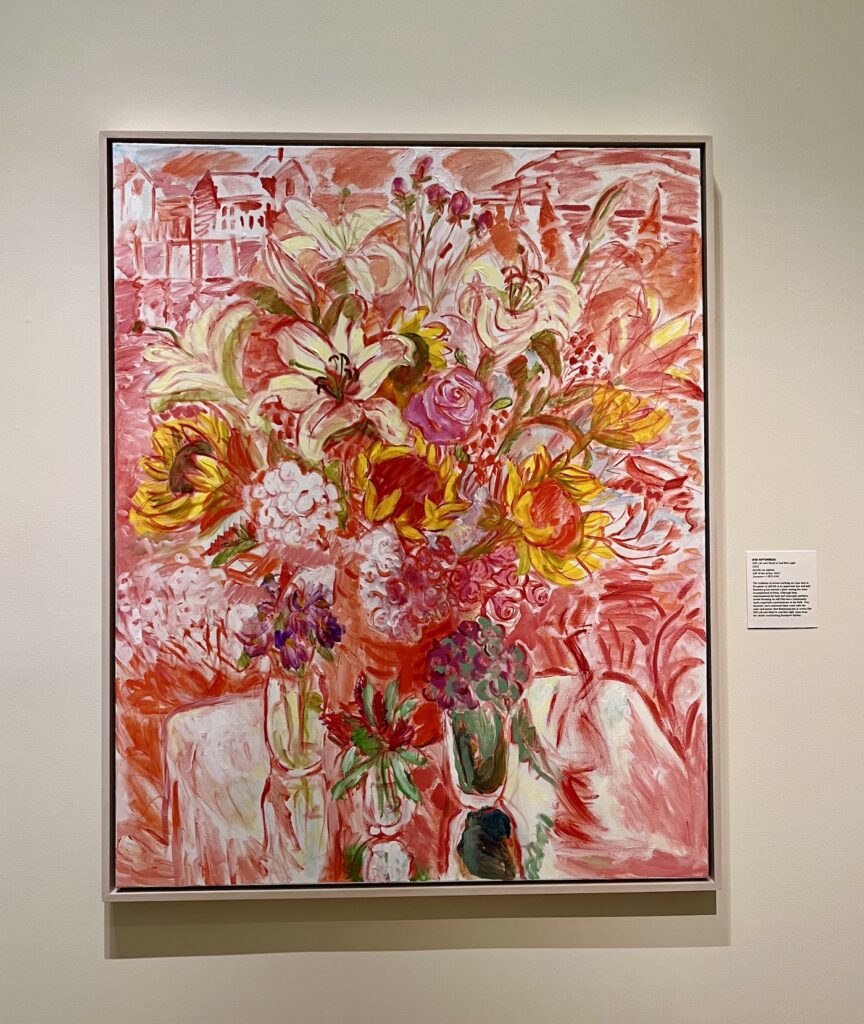
(Of special note: On September 7, CAM hosts CAMTalk: Exhibition Series Panel Discussion: Contemporary Women in the Collection with Ruth Mordecai, Gabrielle Barzaghi, Susan Erony, Clara Wainwright, and Judi Rotenberg.)
In other galleries
Even beyond the third floor, eagle-eyed visitors will find more art by women throughout CAM.
More Cecilia Beaux
There are two other paintings by Cecilia Beaux. Jimmie, a portrait of a small boy in white, is on the second-floor landing. On the first floor, the Cape Ann Gallery presents Beaux’s Portrait of Elizabeth Tappan Wright, which the museum acquired in 2021.
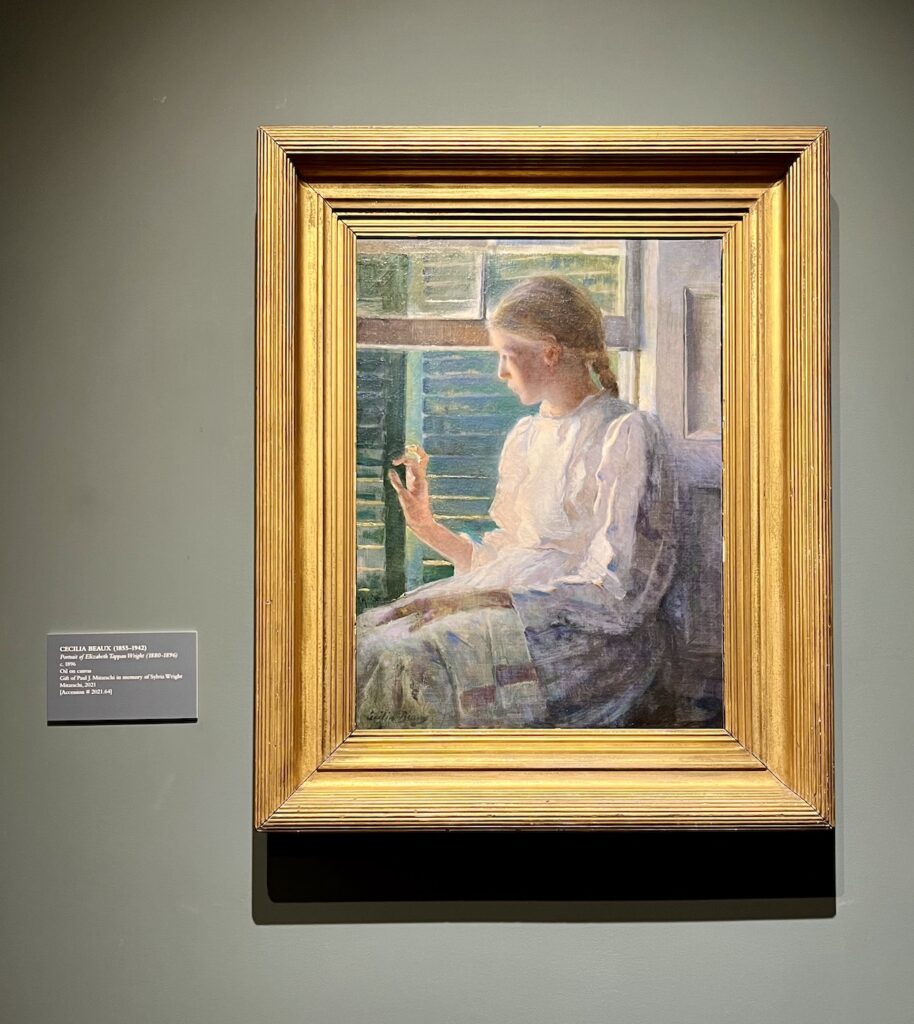
Women artists of the more distant past
Also in this gallery is Portrait of Hannah Fuller (Smith) Stanwood, one of a few CAM-held paintings by Susannah Paine. The wall text attests that Paine was one of the first portrait painters to work in the area.
In the Lane Gallery is Field Beach, Stage Fort Park by Mary Blood Mellen, a student and collaborator of Fitz Henry Lane.
On the walls of the Davis Parlor are two mourning embroideries. According to the names on the frames, one is by Sarah Fuller; the other is by Sally Somes. Hanging nearby is Rural Innocence, a bucolic scene depicted in needlework. The name on the frame, which again presumably identifies the creator, is Amanda Nash.
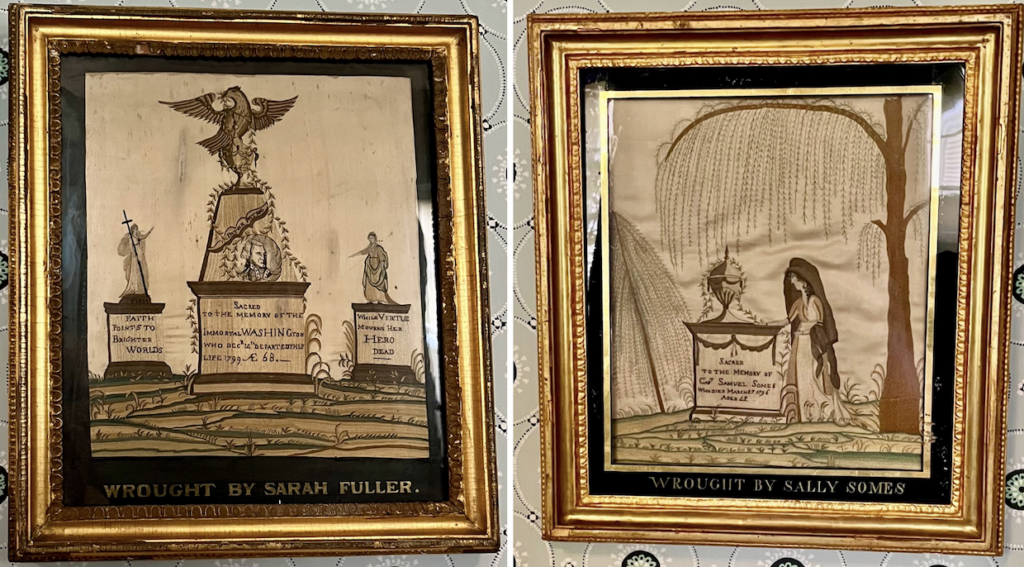
In the reception area is Strong Breezes and Passing Clouds, by Diane KW. This installation incorporates ceramic shards collected from shipwrecks in the South China Sea, and the Atlantic and Pacific oceans.
And CAM houses the largest collection of work by the Folly Cove Designers. This group of designer-craftsmen did include men, but the vast majority of its members were women. They worked together from 1938 to 1969 under the leadership of Virginia Lee Burton Demetrios. (Fans of children’s literature will recognize this name: she wrote Mike Mulligan and his Steam Shovel). They produced carefully wrought designs cut into linoleum blocks and printed (primarily) on fabric.
A commendable commitment to art by women
The museum owns many more works by women of the distant and more recent past. Some of these may not be on display just now; others, your correspondent may have missed. Ruin by a Stream, by Abigail Somes Davis is one of the earliest known paintings by a woman in the collection. It dates to the late 1790s; the artist was apparently 14 when she made it. CAM also holds work by American sculptor Anna Vaughn Hyatt Huntington. And in 2022 the museum acquired the quilt Lanes Cove, by Doris Elizabeth Prouty—a gift of the Prouty family. (In the same year, CAM presented the exhibition In Her Mind’s Eye: Doris Elizabeth Prouty.)

Clearly, CAM’s permanent collection is rich in works by female makers. How did this circumstance come to be? According to the wall text in the Women Artists on Cape Ann exhibition, female artists at the summer art colony abounded in the early twentieth century. So perhaps to an extent the museum benefits from proximity to a location where women artists congregated. Possibly the museum’s focus on collecting artwork and objects related to the history and culture of the region play a role, insofar as it was typically women who created material artifacts such as mourning embroideries and quilts. But it also seems that museum staffers, past and present, have consistently shown a commitment to honor achievements by all artists.
More women artists around Gloucester
As it turns out, CAM is not the only Gloucester museum to hold work by historic women artists! Visitors will also find paintings—and other forms of art—by female makers at these local attractions:
Sargent House Museum displays a floral still life painting by Mary Plummer. It also boasts two portraits by Jane Stuart (whose father was Gilbert Stuart). In 2022 the Ormond family, descendants of Emily’s sister Violet, presented the museum with 15 watercolors by Emily Sargent. Some of the works are in storage, but five of them are on view in the museum tour. (Other institutional recipients of Emily Sargent works include the Museum of Fine Arts, Boston; the National Gallery of Art; The Metropolitan Museum of Art; the Brooklyn Museum; London’s Tate; and Oxford University’s Ashmolean Museum. Learn more about Emily Sargent, and the donations to museums, in Sarah Cascone’s article for Artnet.)
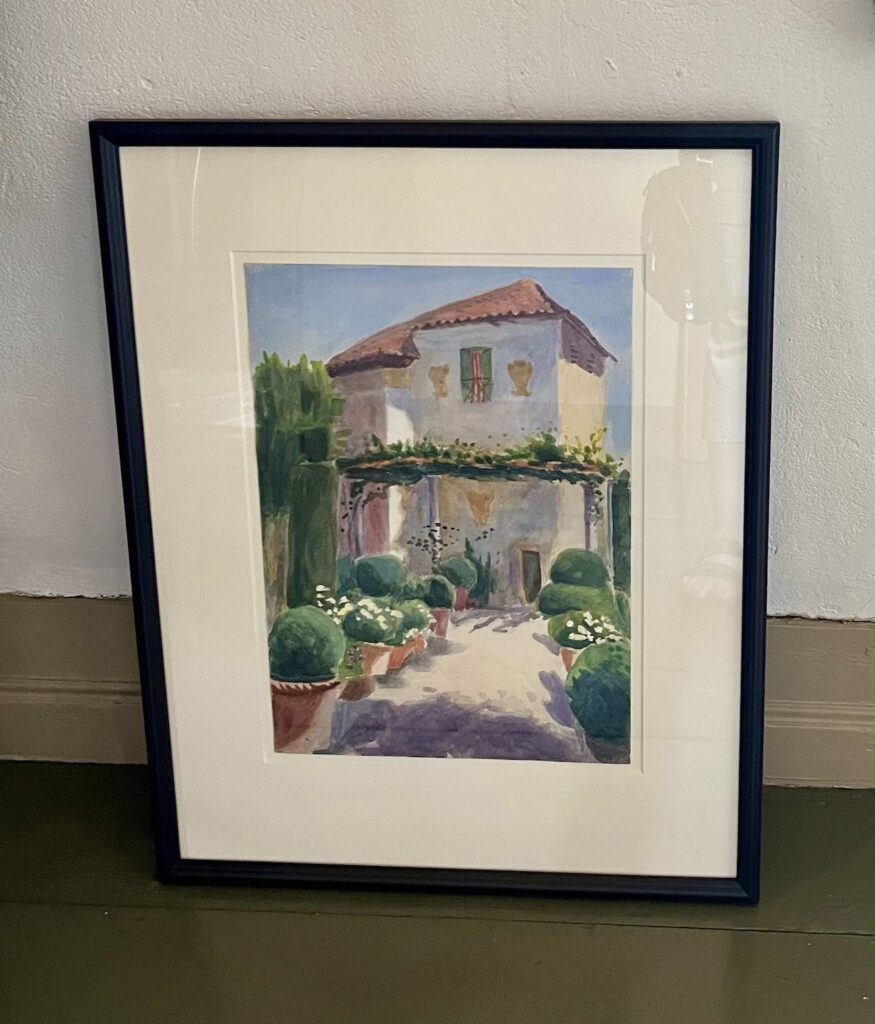
And at Hammond Castle Museum, visitors can see needlework by Natalie Hays Hammond, as well as paintings by Irene Fenton Hammond.
Women Artists on Cape Ann 1870–1970 is on at Cape Ann Museum (CAM) through September 29, 2024. Visitors interested in this exhibition may also wish to visit Making Marks: Historic Women Artists Of Cape Ann, which will run at Rockport Art Association & Museum’s Wengenroth Gallery from Saturday, October 26–December 31, 2024.
Erika Gaffney is Founder of Art Herstory. Follow Erika on LinkedIn, Facebook, Bluesky, and (at least for now) Twitter.
More Art Herstory posts about American women artists:
Women Artists from Savannah at the Telfair Academy Museum, by Julie Allen
Illuminating Sarah Cole, by Kristen Marchetti
Defining Moments: Mary Cassatt and Helen McNicoll in 1913, by Julie Nash
Susie M. Barstow: Redefining the Hudson River School, by Nancy Siegel
Women Reframe American Landscape at the Thomas Cole National Historic Site, by Erika Gaffney
Science, Nature, and Music in the Art of Alma Thomas, by Erika Gaffney
Laura Seymour Hasbrouck, A Painter of the Hudson River School, by Lili Ott
Portraying May Alcott Nieriker, by Julia Dabbs
Celebrating Eliza Pratt Greatorex, an Irish-American Artist, by Katherine Manthorne
The Ongoing Revival of Matilda Browne, American Impressionist, by Alexandra Kiely
More Art Herstory exhibition posts:
Museum Exhibitions about Historic Women Artists: 2024
The Floral Art of Emily Cole, by Erika Gaffney
Frida: Beyond the Myth at the Dallas Museum of Art, by Olivia Turner
Making Her Mark Leaves its Mark at the Art Gallery of Ontario, by Isabelle Hawkins
Early Modern European Women Artists at the Montreal Museum of Fine Arts, by Erika Gaffney
Carlotta Gargalli 1788–1840: “The Elisabetta Sirani of the Day,” by Alessandra Masu
Making Her Mark, An Essential Corrective in the History of Art, by Chadd Scott
Marie Laurencin: Sapphic Paris, A Review, by Alice M. Rudy Price
Masters and Sisters in Arts, by Jitske Jasperse
Reflections on Making Her Mark at the Baltimore Museum of Art, by Erika Gaffney
Thoughts on Feminist Art History in the Wake of Artemisia: Vrouw & Macht at Rijksmuseum Twenthe, by Jitske Jasperse
Sofonisba Anguissola in Holland, an Exhibition Review, by Erika Gaffney with Cara Verona Viglucci
Thérèse Schwartze (1851–1918), by Ien G.M. van der Pol
Anna Dorothea Therbusch: A Woman Painting Against Eighteenth-century Odds, by Stephanie Pearson
Rosa Bonheur—Practice Makes Perfect, by Ien G.M. van der Pol
The Many Faces of Suzanne Valadon, by Suzanne Singletary
Plautilla Bricci: A Painter & “Architettrice” in Seventeenth-century Rome, by Alessandra Masu



